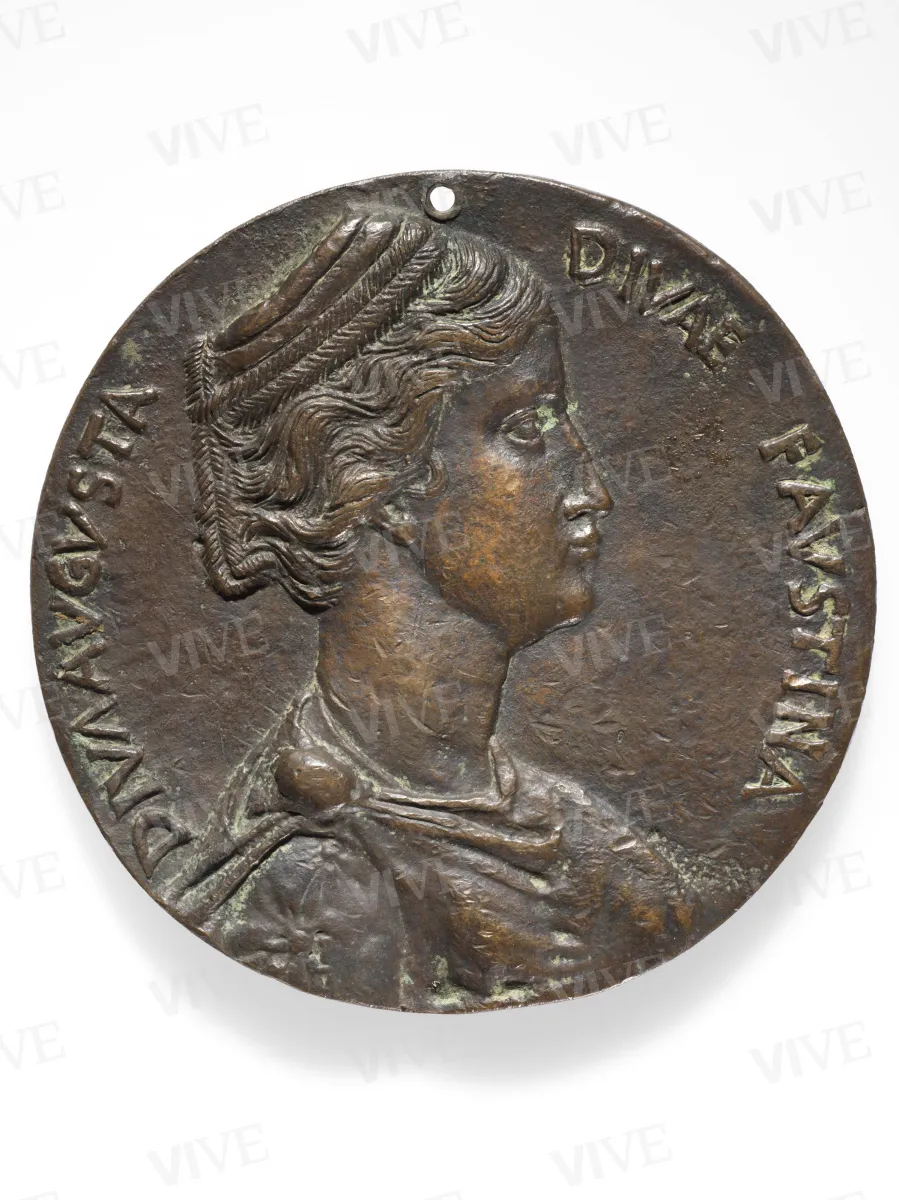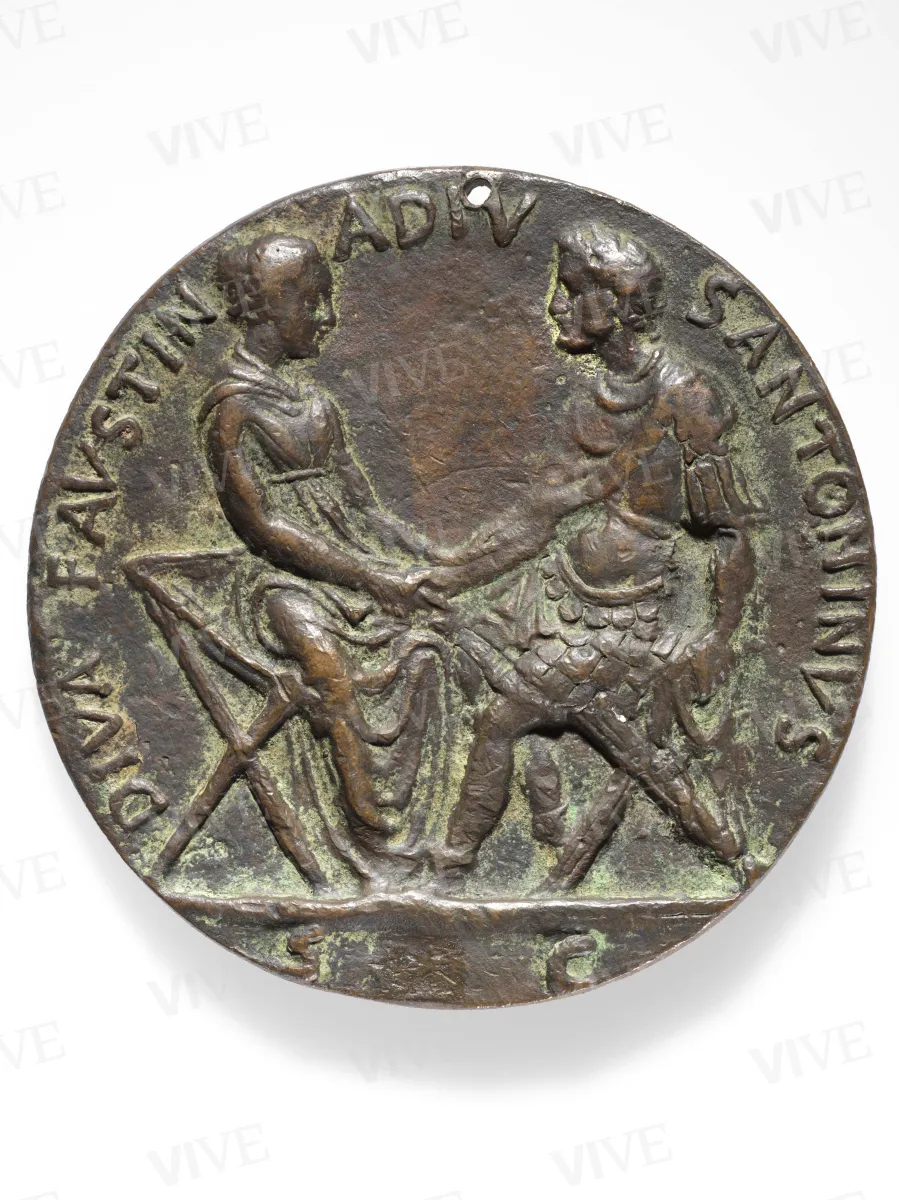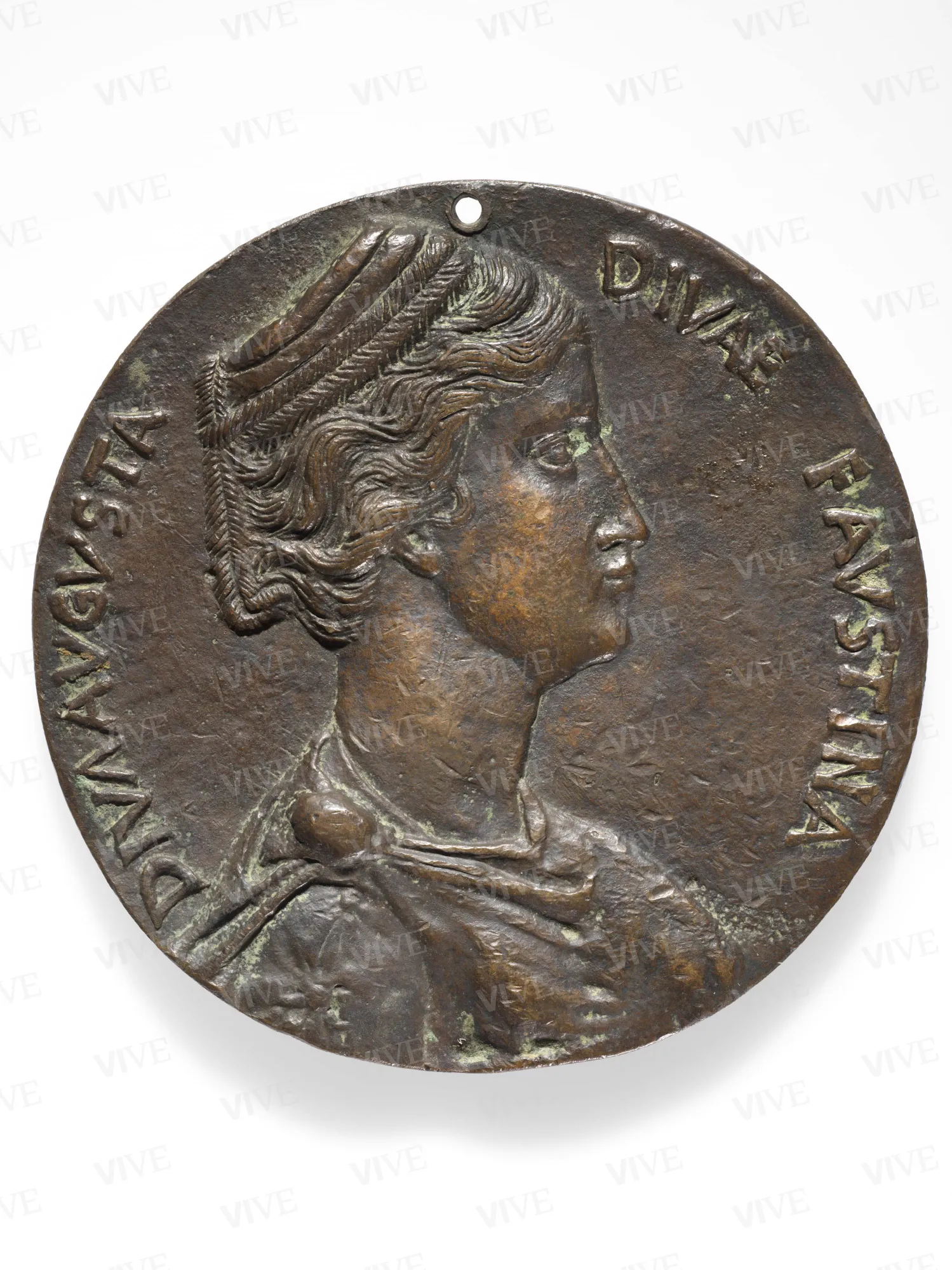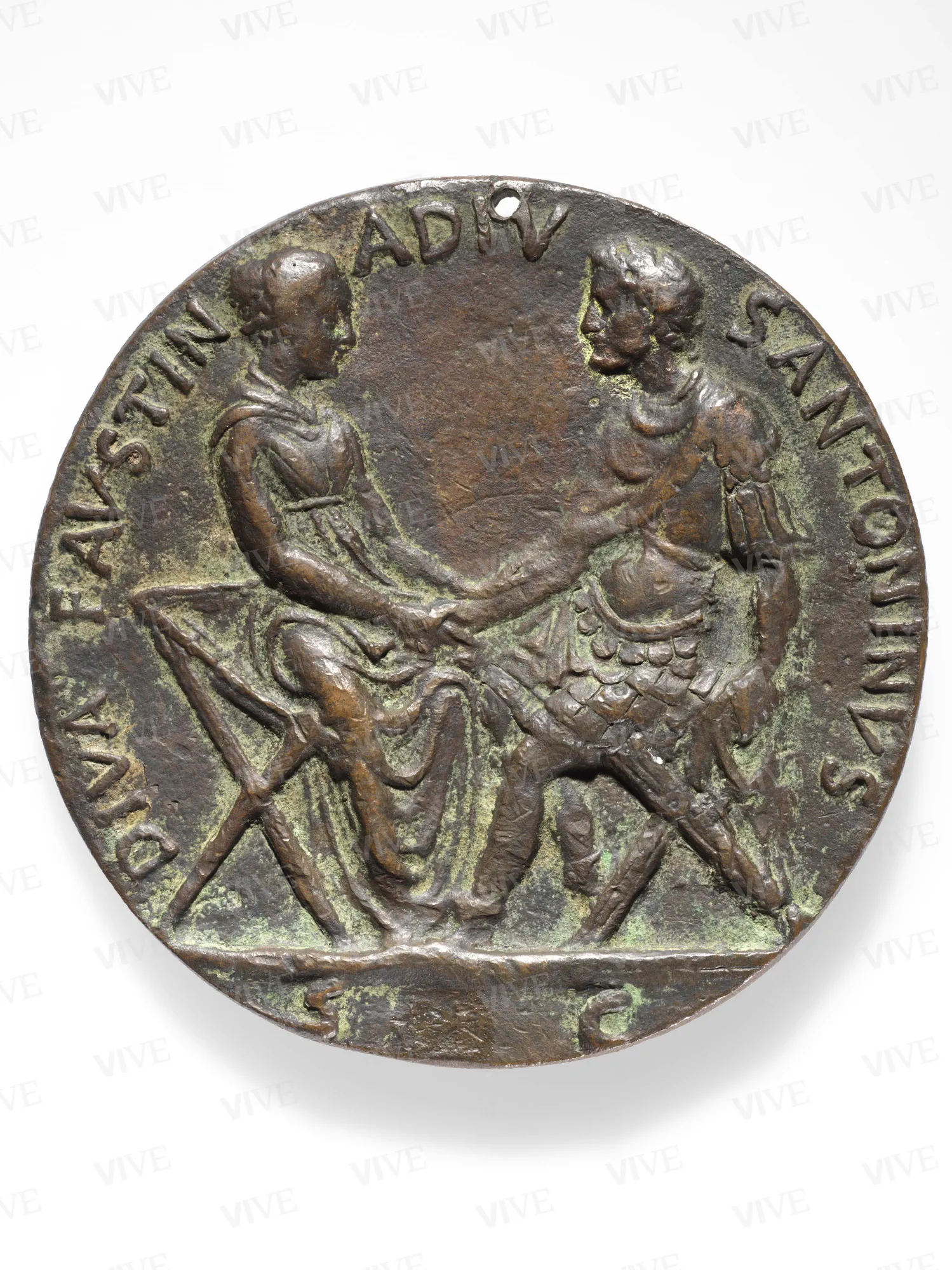Medal with Faustina the Elder/Antoninus Pius and Faustina holding hands
Antonio Averlino called Filarete 1445
This medal features Faustina the Elder, wife of the Roman emperor Antoninus Pius. The reverse side shows a scene referring to the marriage pact, with Antoninus Pius depicted alongside her. The medal was created by the Florentine artist Antonio Averlino, also known as Filarete, and belongs to the Renaissance collection of objects inspired by classical antiquity that were popular among collectors in the mid-fifteenth century. Faustina the Elder was frequently depicted because she symbolized righteousness and marital fidelity.
This medal features Faustina the Elder, wife of the Roman emperor Antoninus Pius. The reverse side shows a scene referring to the marriage pact, with Antoninus Pius depicted alongside her. The medal was created by the Florentine artist Antonio Averlino, also known as Filarete, and belongs to the Renaissance collection of objects inspired by classical antiquity that were popular among collectors in the mid-fifteenth century. Faustina the Elder was frequently depicted because she symbolized righteousness and marital fidelity.
Details of work
Catalog entry
The obverse of the coin features the bust of Faustina the Elder facing right. The Roman empress is depicted with an intricate hairstyle composed of braids that gather into a high bun atop her head, which has been meticulously engraved using a cold chisel in this example. Her hair, styled in sinuous waves between her forehead and her partially covered ear, complements her ancient-style dress. The dress is secured on her right shoulder by a bulla, which, in the most well-preserved specimens of the medal, can be seen as an oval bud with four petals (Zaccariotto 2020, pp. 106–107, n. 78).
Under the robe, a sleeve with openwork fabric and some small buttons can be glimpsed. On the reverse, Faustina herself is seated on a folding saddle, similar to a sella castrensis, and with both hands she holds the right hand of Antoninus Pius, seated facing her, who looks at her. While Faustina is wearing a draped robe, which is floor-length and tightened under the bust with a belt, the emperor is wearing armor consisting of a skirt with pteruges, a lorica muscleata, a shoulder strap in the form of an acanthus wreath with straps, and a long cloak held in place on the belly with a knotted leather strap. The philological care of such details testifies to the intense study of ancient sculpture and medallic art by Filarete (c. 1400–1469). Anna Galeria Faustina, known as Faustina the Elder (to distinguish her from her daughter, Faustina the Younger), was the wife of the emperor Antoninus Pius and for this reason became Augusta of the Roman Empire between 138 CE, the date her husband obtained the imperial title, and 140 CE, when she died at a relatively young age (she was born in 104 CE). Upon her death, Antoninus Pius deified her and paid her great honors. We recognize her face because it was stamped on the gold coins of her husband’s reign, in which Faustina appears in profile, with an elaborate hairstyle also decorated with pearls and a dress fastened on her right shoulder, elements that were taken from the ancient coin to create this great Renaissance medal.
The reverse side of the coin illustrates the wedding of Faustina and Antoninus Pius, where the couple held each others’ hands and gazed into each other’s eyes to seal their marriage (Pollard, Luciano 2007, I, pp. 248–249, n. 229). In 1930, George Francis Hill classified this medal, along with similar ones depicting characters from ancient Rome, as works of the Master of the Roman Emperors (Hill 1930, I, pp. 186–187). The author was identified as Florentine Antonio Averlino, known as Filarete, in the seventies upon comparison with a bronze oval portraying the master's self-portrait (London, Victoria & Albert Museum, inv. 194–1866) and the central bronze door of St Peter’s Basilica in Rome, completed by him in 1445 (Seymour 1973).
This exhibit is closely related to the medallions depicting ancient figures created by Filarete. The alphabetical characters are somewhat uncertain, not particularly well-finished, and arranged without a precise balance of full and empty spaces, as evidenced in the border on both the obverse and reverse sides of the medallion. Furthermore, some figures are similar, such as Nero seated on a curule saddle in armor, which resembles Antoninus Pius on the reverse side of the medallion (Spencer 1979). The door also features several ancient heads in profile within acanthus leaf swirls: a young emperor with a laurel wreath closely resembles Antoninus Pius, while Faustina the Elder is easily recognizable due to her hairstyle and nearly identical profile on this medal. Filarete trained in Lorenzo Ghiberti's workshop before moving to Rome to serve Eugene IV, who commissioned him to create the bronze doors of St Peter’s Basilica. Subsequently, he relocated to Milan and served the Sforza family as an architect. During this period, he authored his Treatise on Architecture, a dialogue comprising text and images discussing Sforzinda, an ideal city shaped like a star (Romanini 1962; Filarete 1972).
During the mid-fifteenth century, antiquarian enthusiasm prompted artists to produce items inspired by classical antiquities, which were highly coveted by collectors. One notable figure was Faustina the Elder, who represented rectitude and marital fidelity (Collareta 2008).
Giulia Zaccariotto
Entry published on 27 March 2025
State of conservation
Good. Normal signs of wear and tear on the bronze.
Inscriptions
Obverse: [within the circle] “DIVA AVGVSTA DIVAE FAVSTINA”;
Reverse: [within the circle] “DIVA FAVSTINA DIV[U]S ANTONINVS [in exergue] S[ENATUM] C[ONSULTUM]”
Provenance
Biblioteca Casanatense (deposited at Palazzo Venezia since 1930).
References
Hill George Francis, A Corpus of Italian Medals of the Renaissance before Cellini, 2 voll., London 1930, I, pp. 186-187;
Romanini Angiola Maria, Averlino, Antonio detto Filarete, ad vocem, in Dizionario Biografico degli Italiani, 4, Roma 1962;
Averlino Antonio, detto Filarete, Trattato di architettura, Finoli Anna Maria, Grassi Liliana (a cura di), Milano 1972;
Seymour Charles Jr., Some Reflections on Filarete’s Use of Antique Visual Sources, in «Arte Lombarda», 38/39, 1973, pp. 36-47;
Spencer John Richard, Filarete, the Medallist of the Roman Emperors, in «The Art Bulletin», 61, 1979, pp. 550-561;
Virgilio Mori, La Biblioteca Casanatense al tempo dell’Audiffredi e la dispersione del suo piccolo Museo, in «Accademie e Biblioteche d’Italia», 55, 1987, pp. 27-41;
Pollard John Graham, Luciano Eleonora, Renaissance Medals, 2 voll., Washington DC 2007, I, pp. 248-249, n. 229;
Collareta Marco, Diva Faustina: una donna, una pettinatura, in Trevisani Filippo, Gasparotto Davide (a cura di), Bonacolsi l’Antico. Uno scultore nella Mantova di Andrea Mantegna e di Isabella d’Este, catalogo della mostra (Mantova, Palazzo Ducale, 13 settembre 2008-6 gennaio 2009), Milano 2008, pp. 82-87;
Hub Berthold, Filarete’s Self-portrait Medal of c. 1460: Promoting the Renaissance Architect, in «The Medal», 66, 2015, pp. 50-60;
Smolucha-Sladkowska Agnieszka, Some Notes on Medals of Marcus Croto and Crescentius, in «The Medal», 72, 2018, pp. 4-17;
Zaccariotto Giulia, La collezione di medaglie Mario Scaglia. II. Catalogo, Bologna-Cinisello Balsamo 2020, pp. 106-107, n. 78;
Cavarra Angela Adriana, La Biblioteca Casanatense e il suo museo svelato: formazione delle collezioni, in Pennestrì Serafina (a cura di), Rischiarare il vero, rilevare il bello. Storie e modelli di tutela e valorizzazione del patrimonio culturale, Roma 2021 (Notiziario del Portale Numismatico dello Stato. Serie Medaglieri Italiani, n. 15), pp. 21-57;
Pennestrì Serafina, Dalla biblioteca al museo. Il Nummophylaceum Casanatense e l’eredità di Giovanni Battista Audifreddi, in Pennestrì Serafina (a cura di), Rischiarare il vero, rilevare il bello. Storie e modelli di tutela e valorizzazione del patrimonio culturale, Roma 2021 (Notiziario del Portale Numismatico dello Stato. Serie Medaglieri Italiani, n. 15), pp. 58-79.














